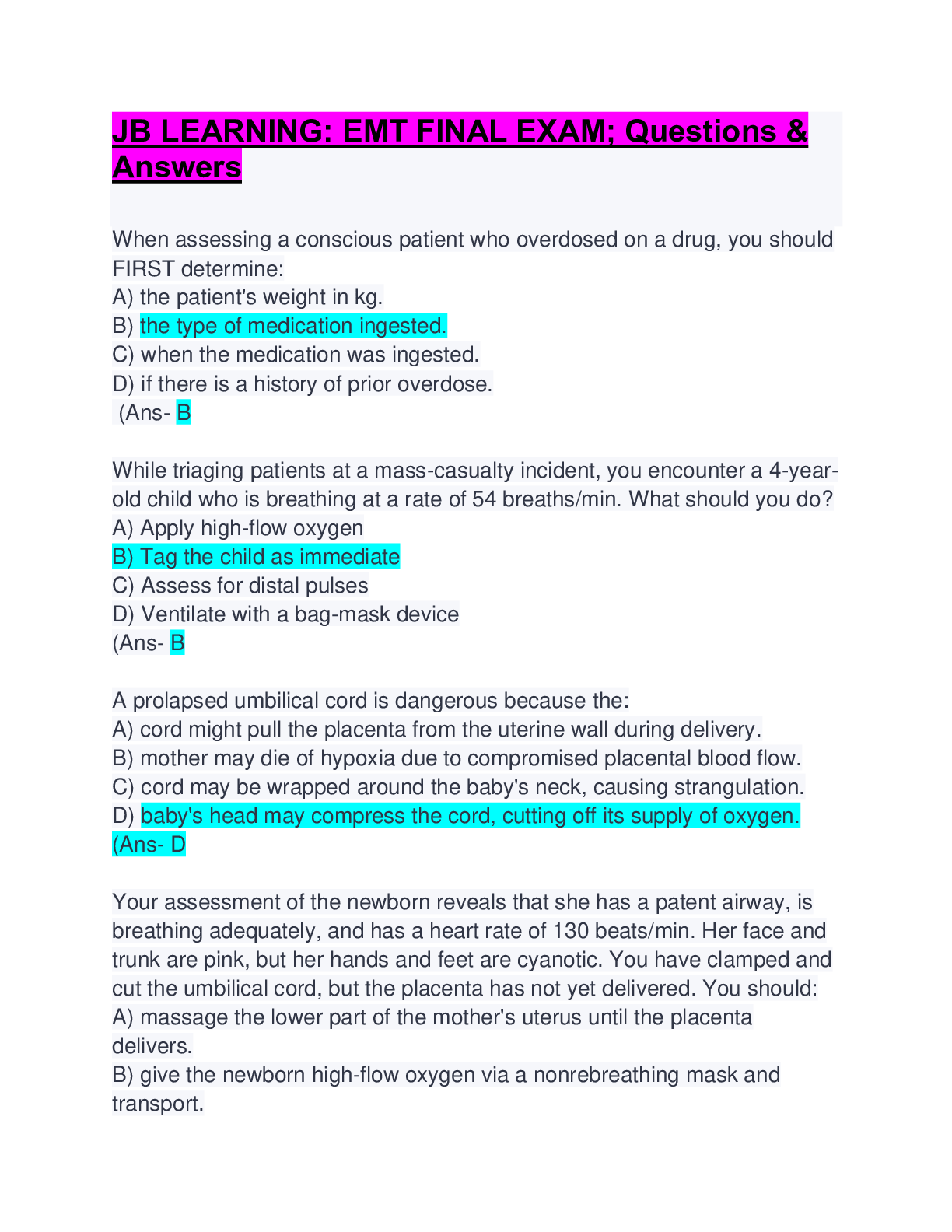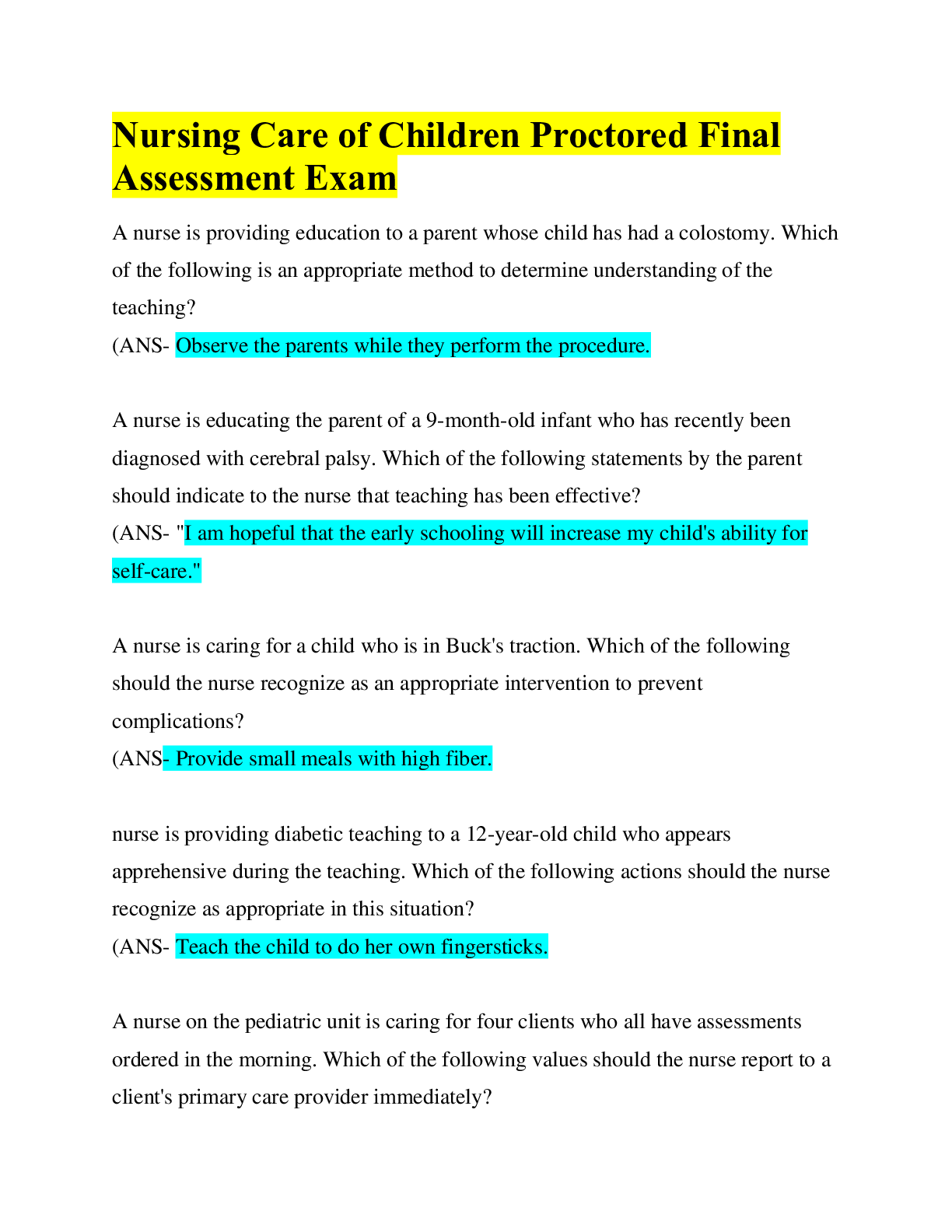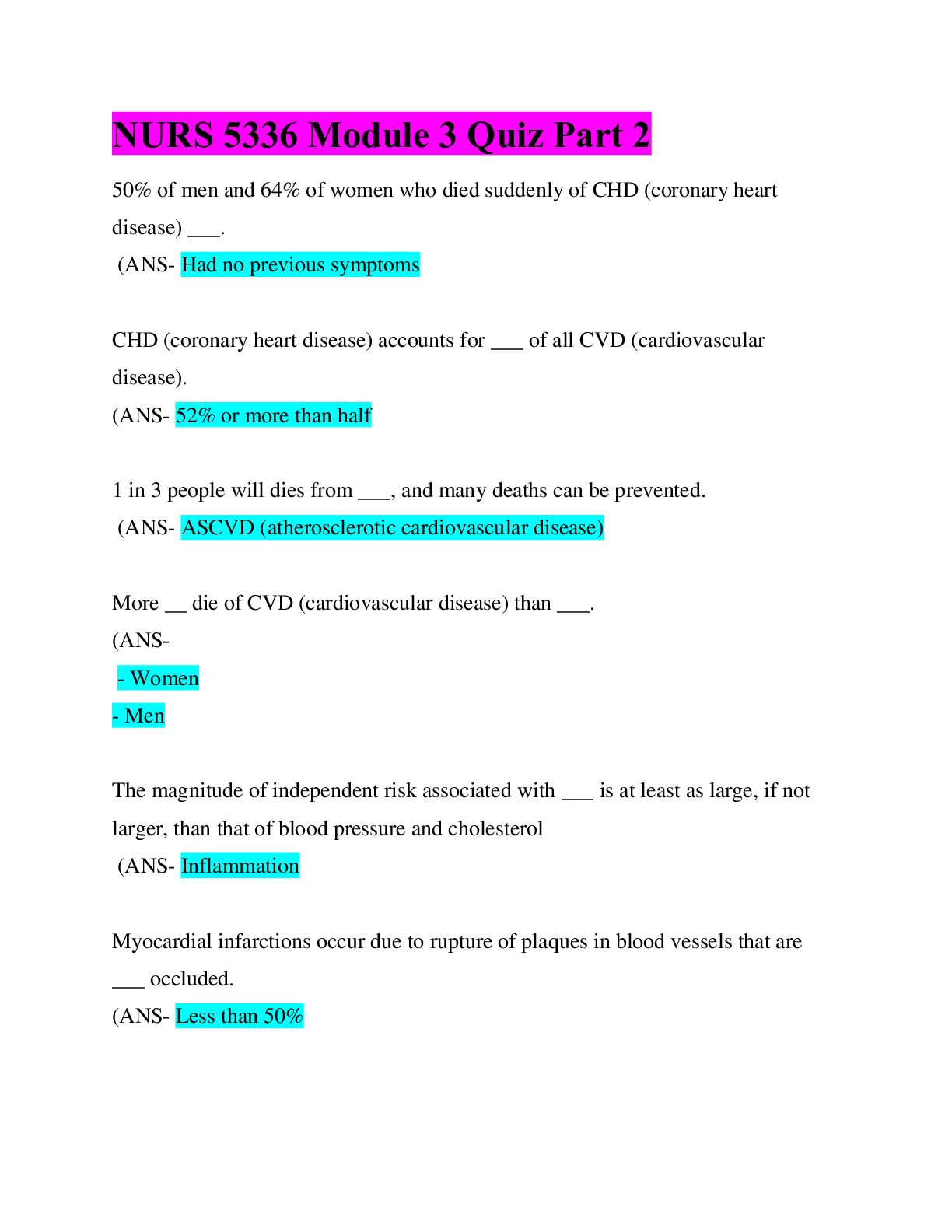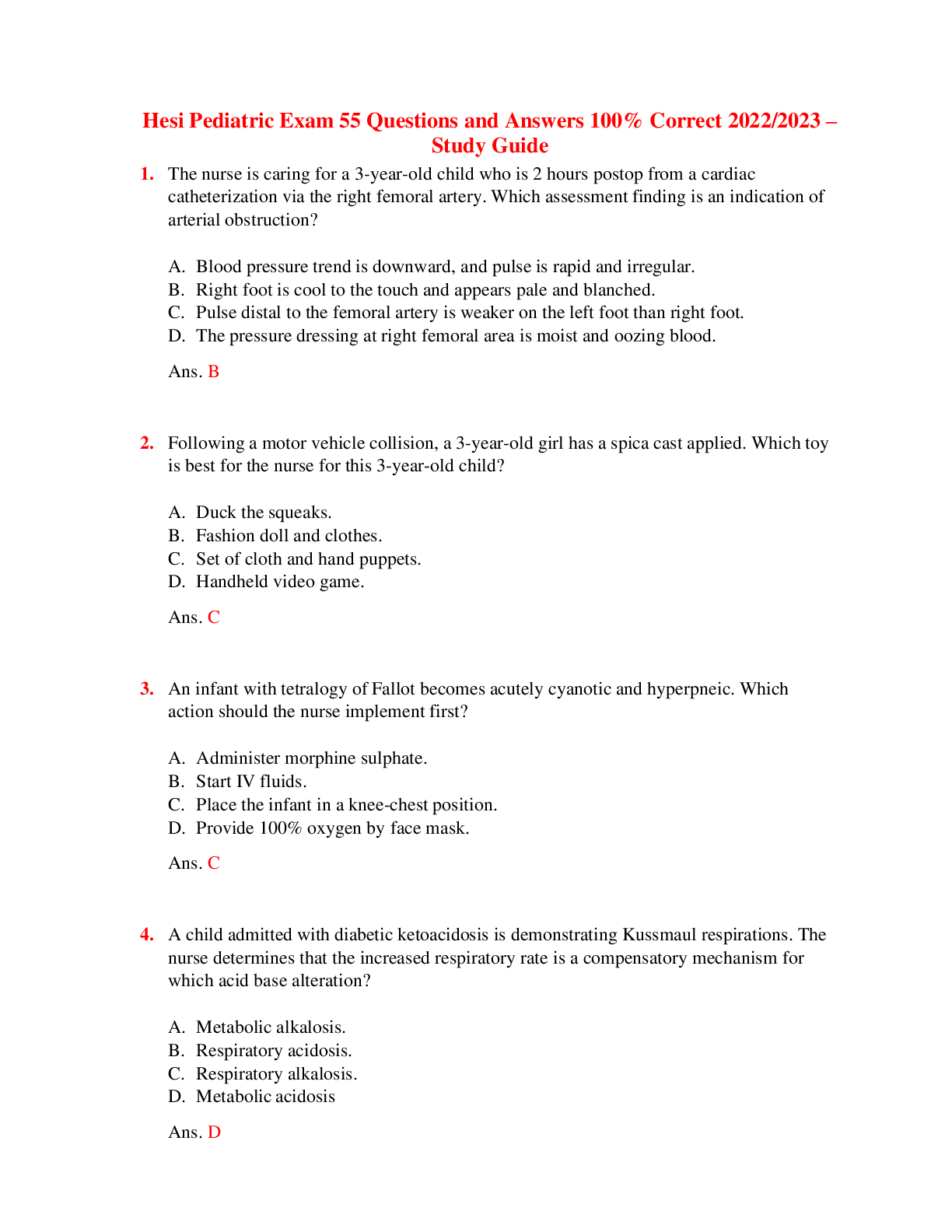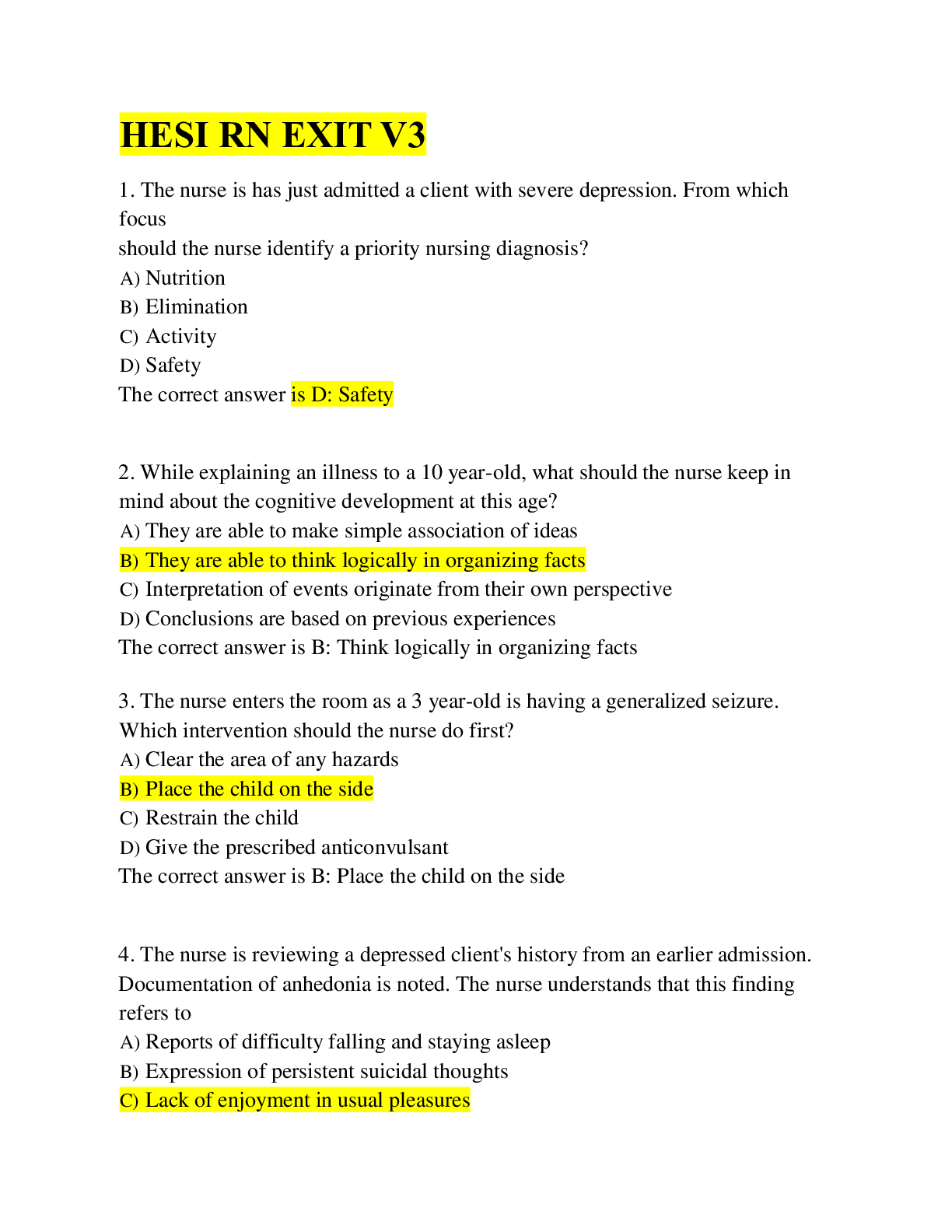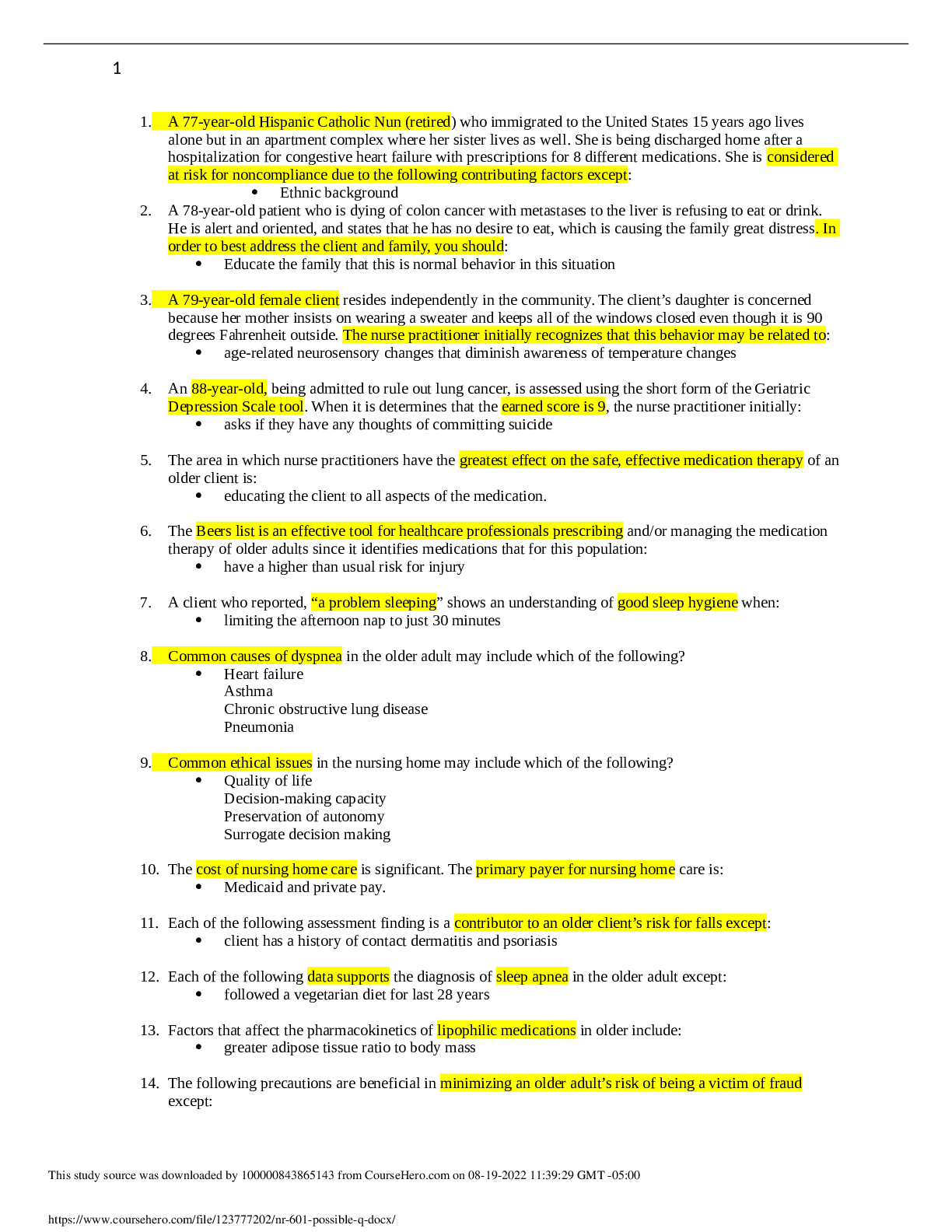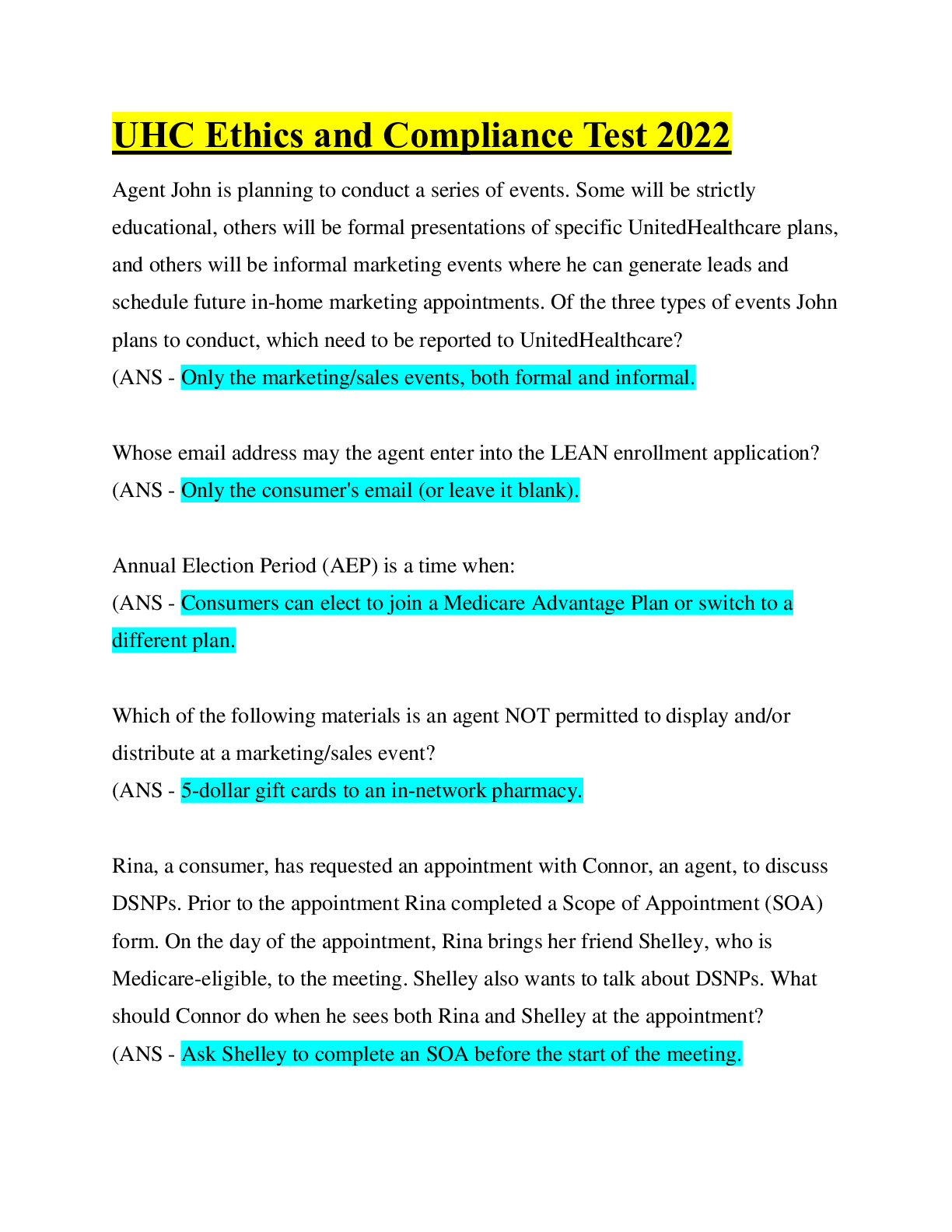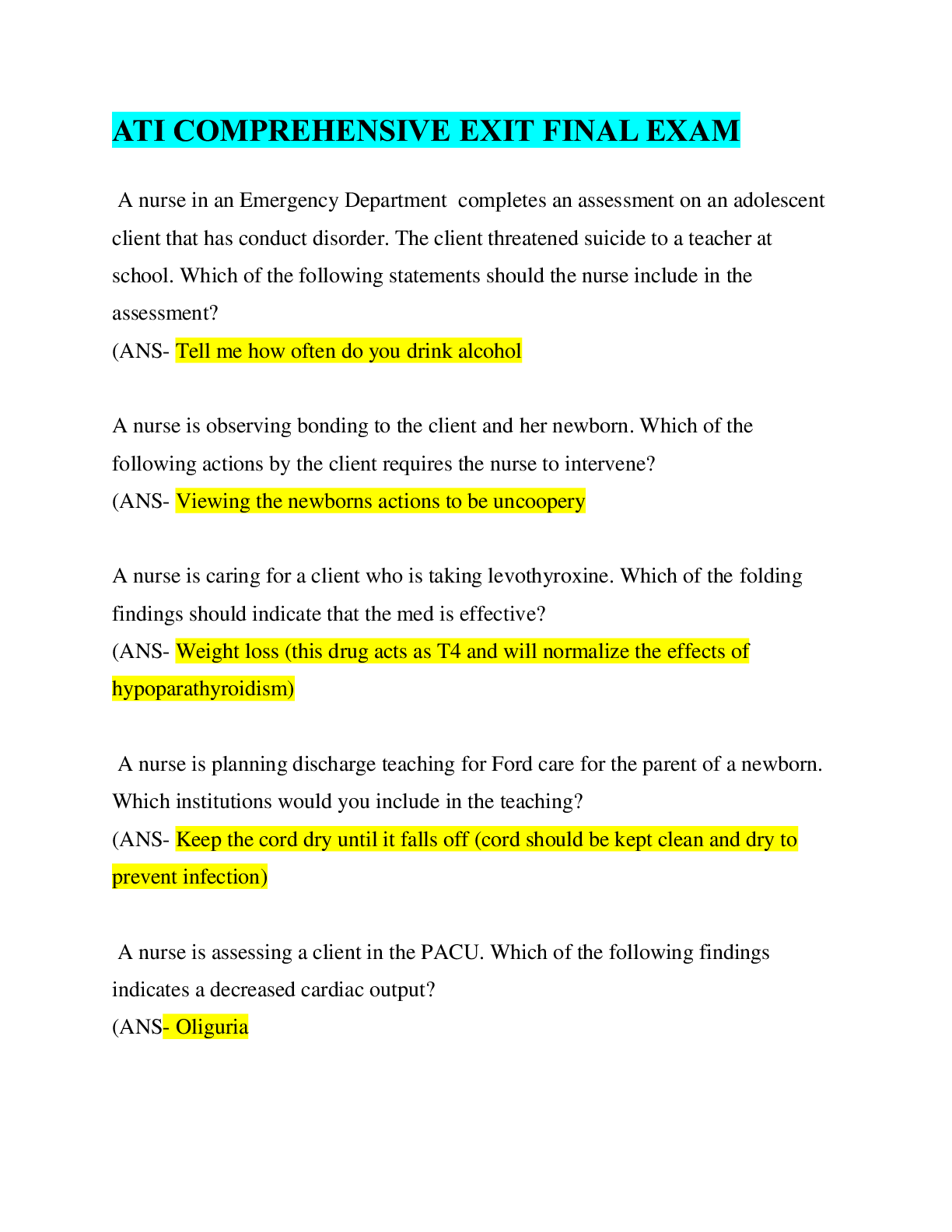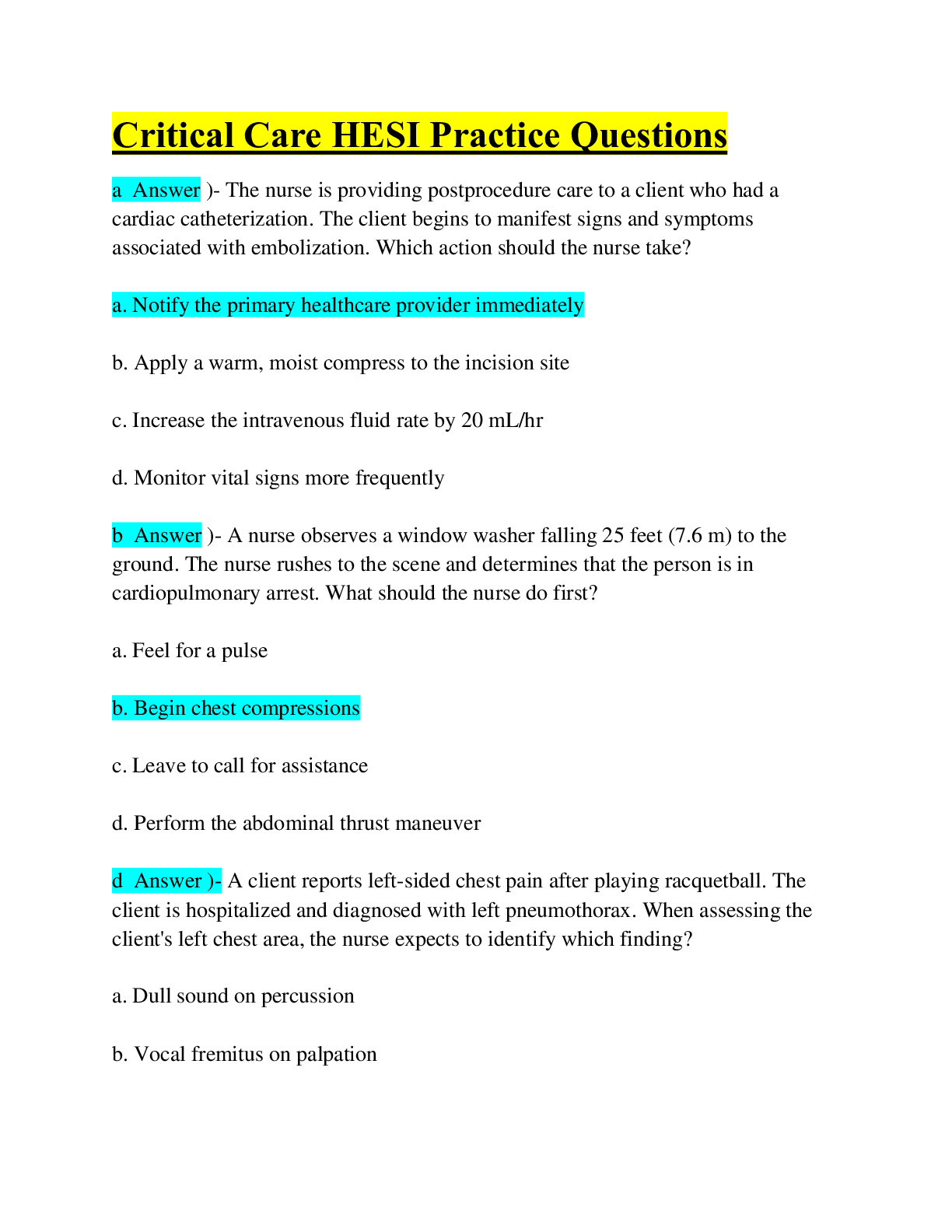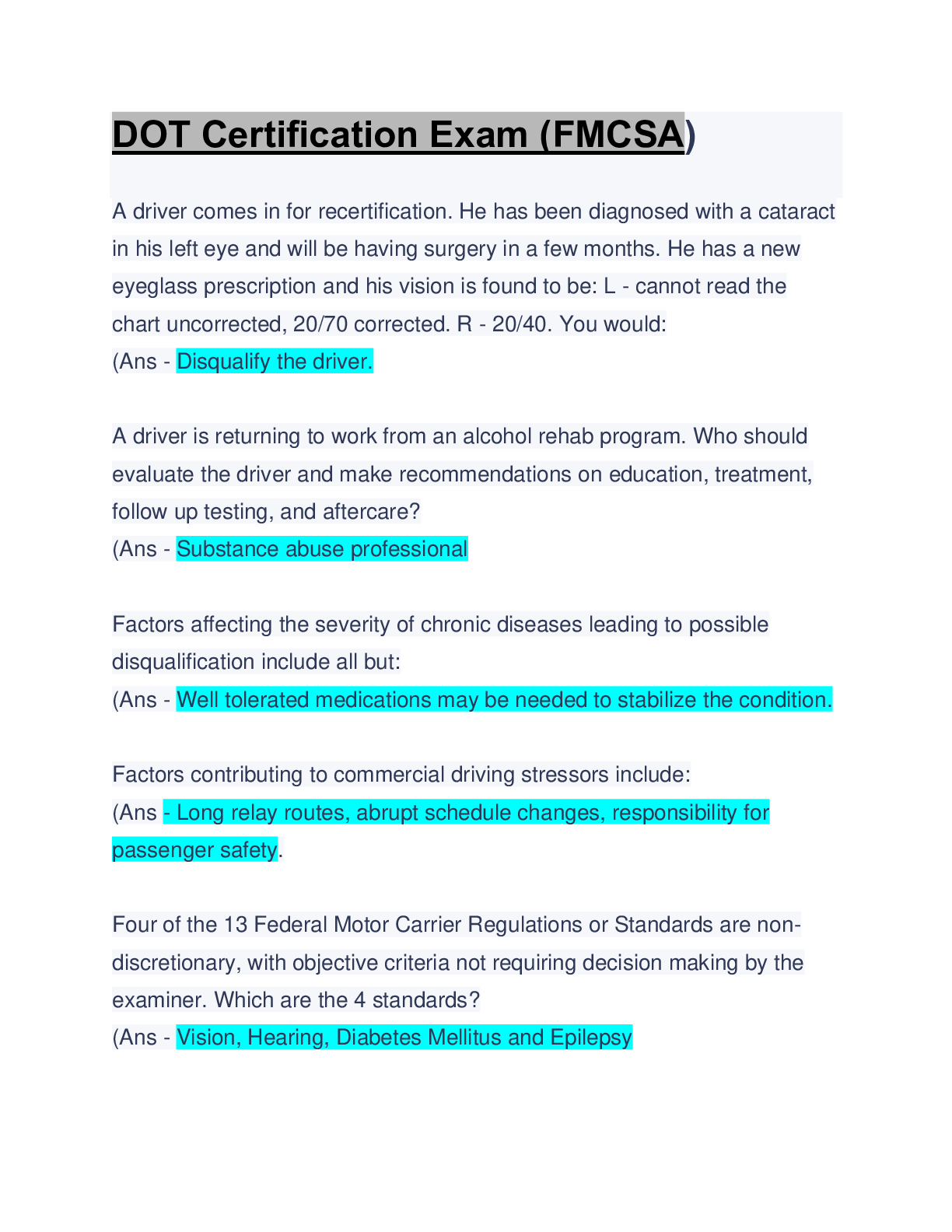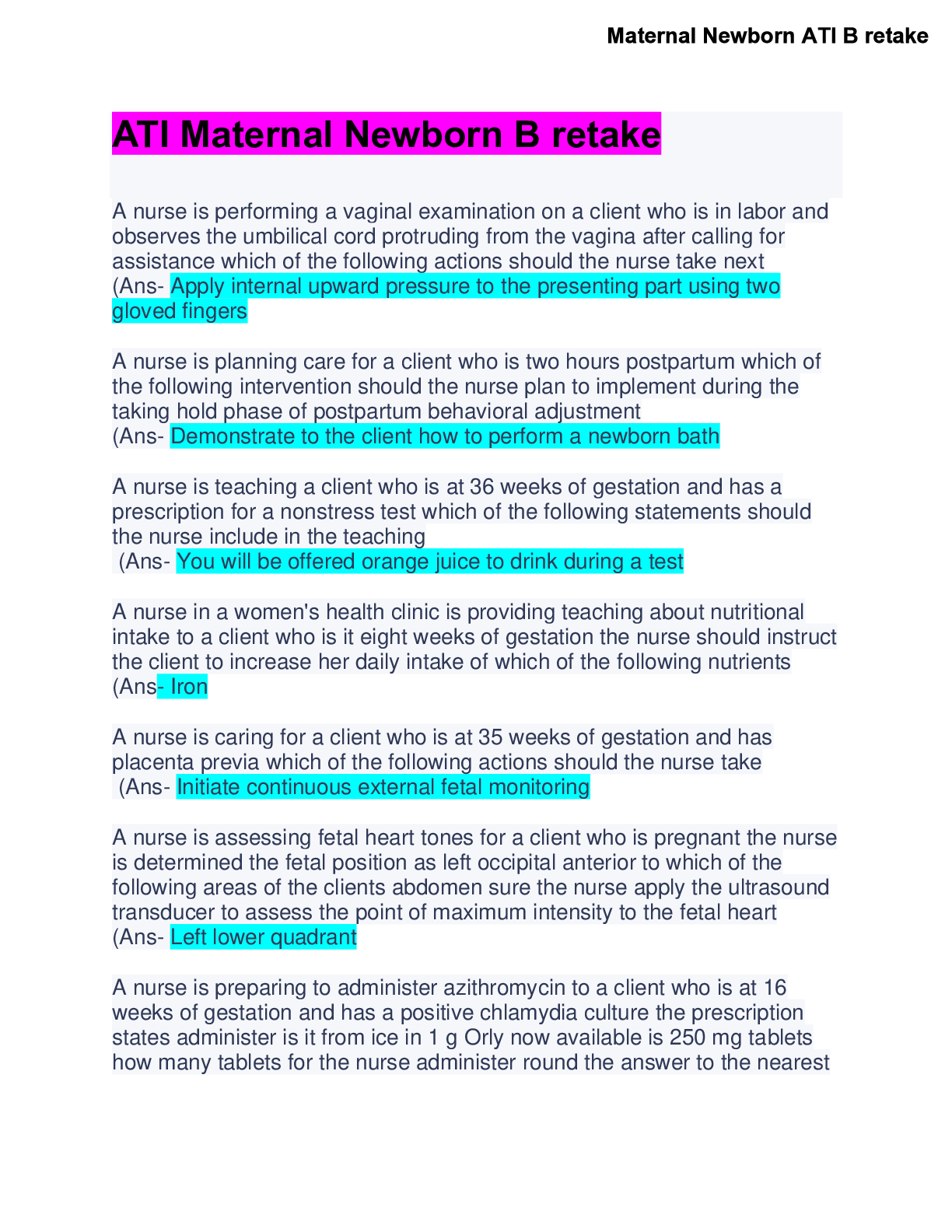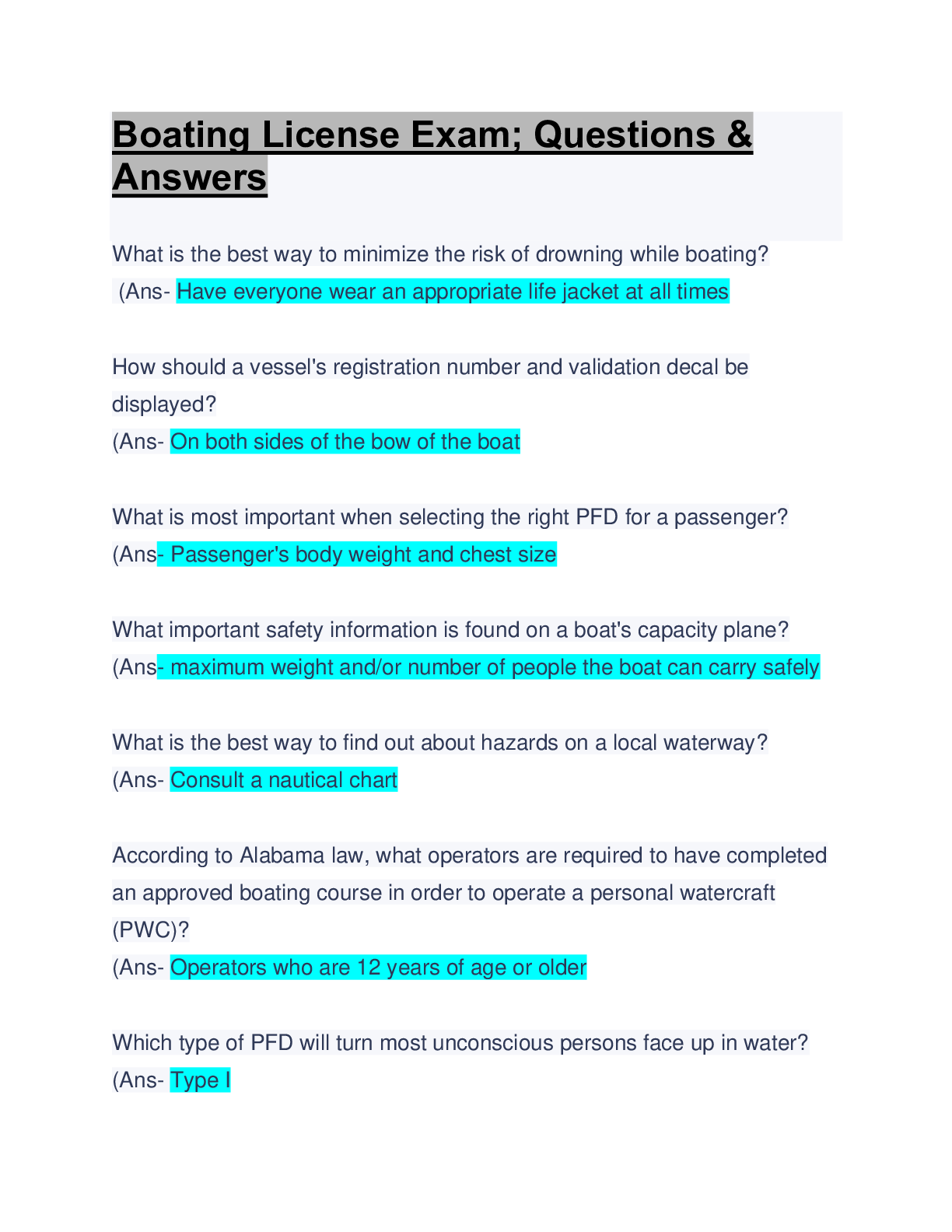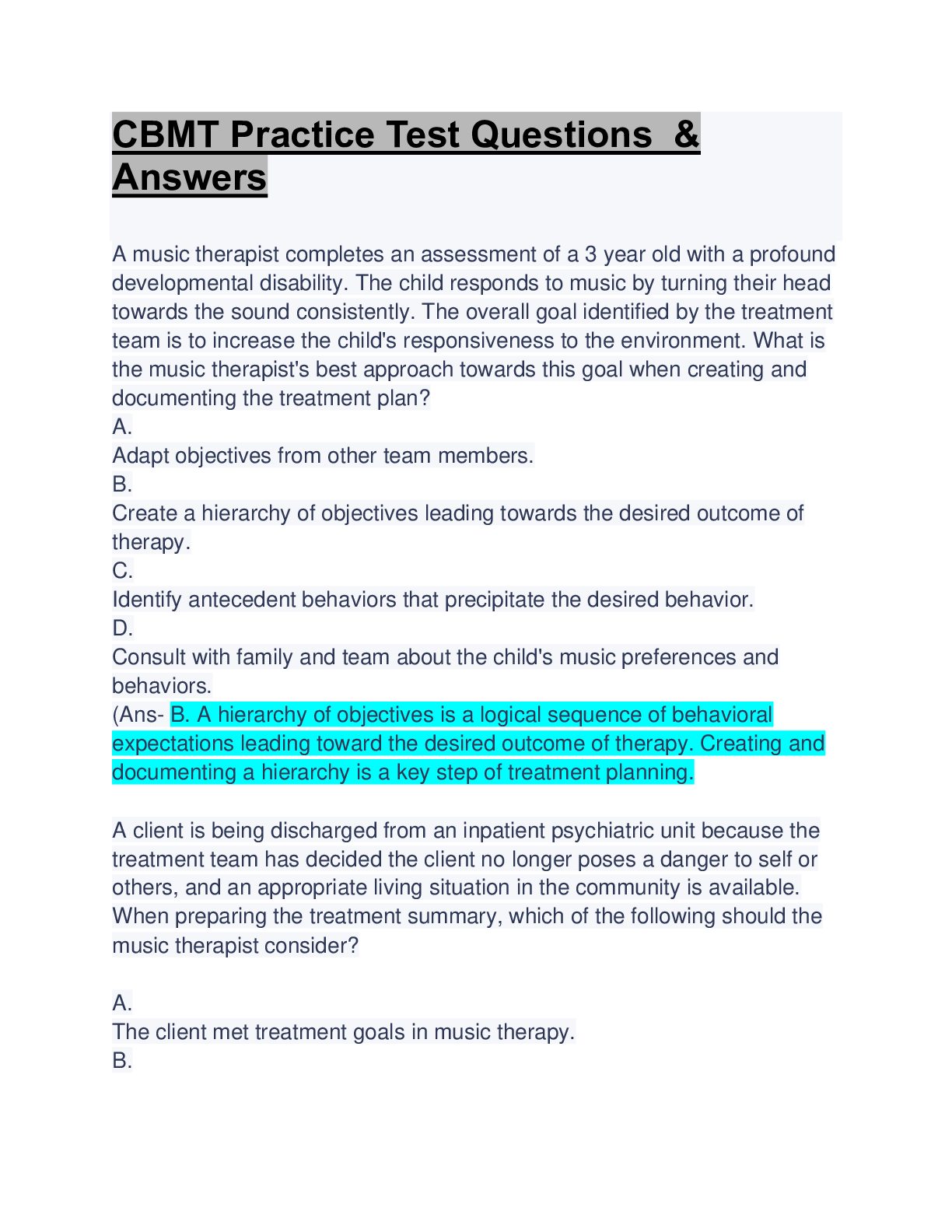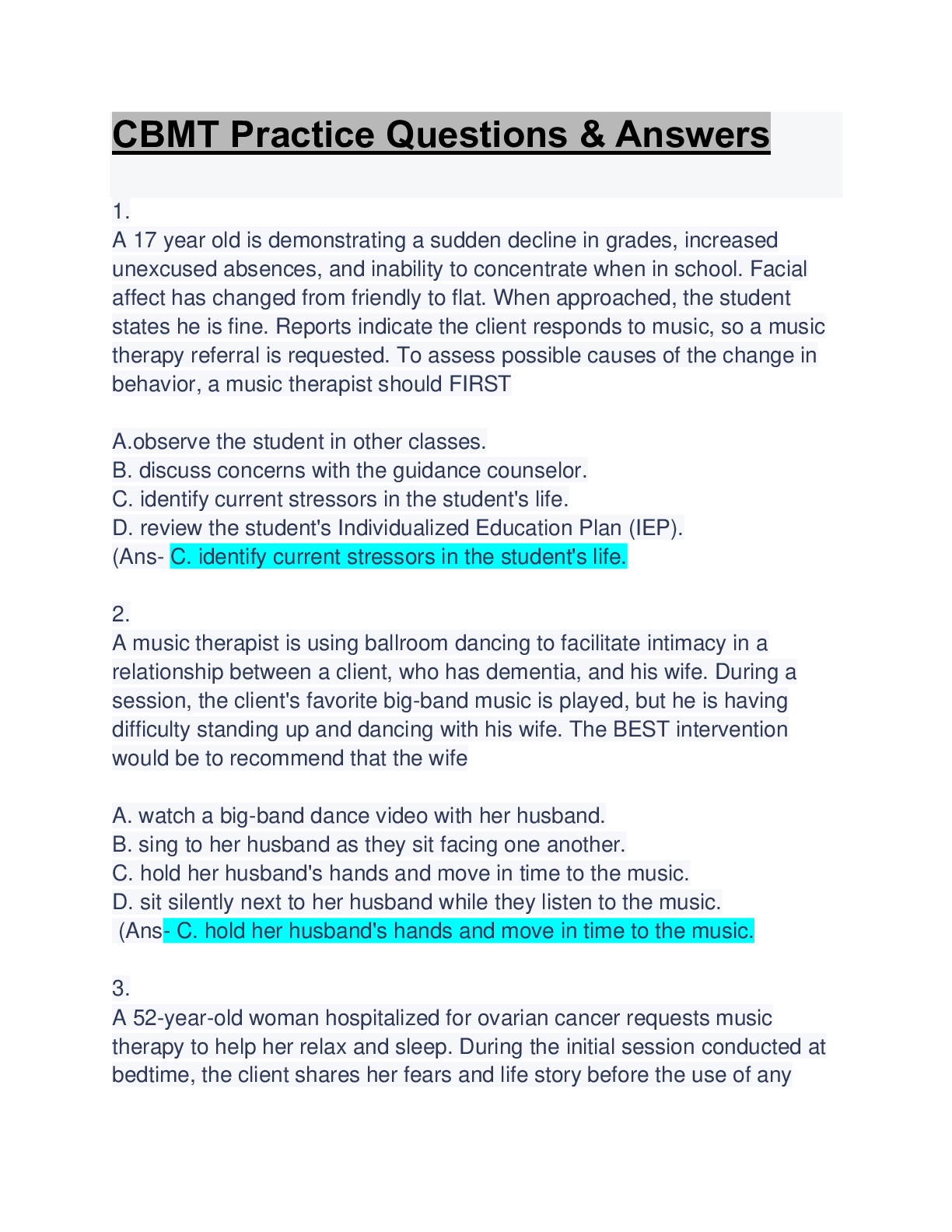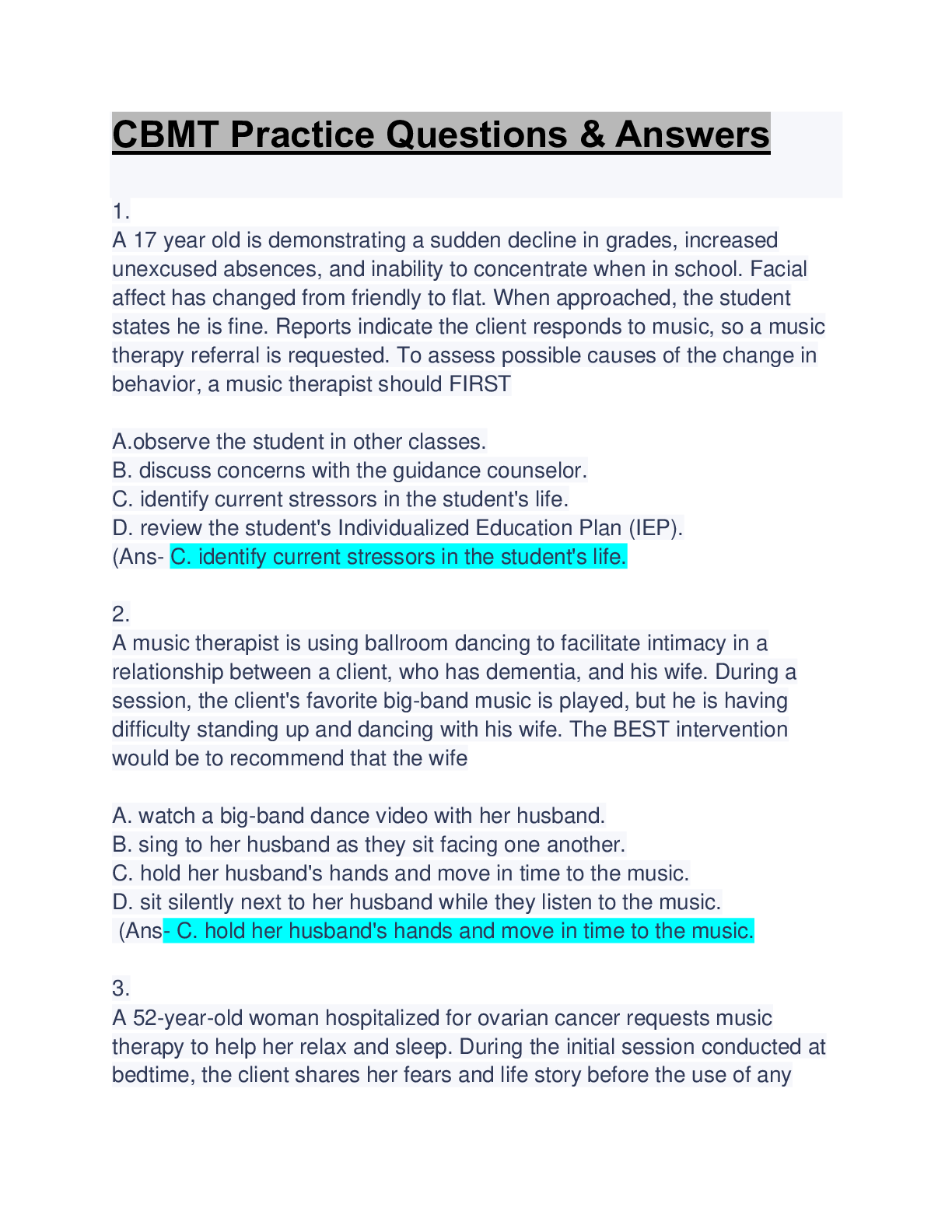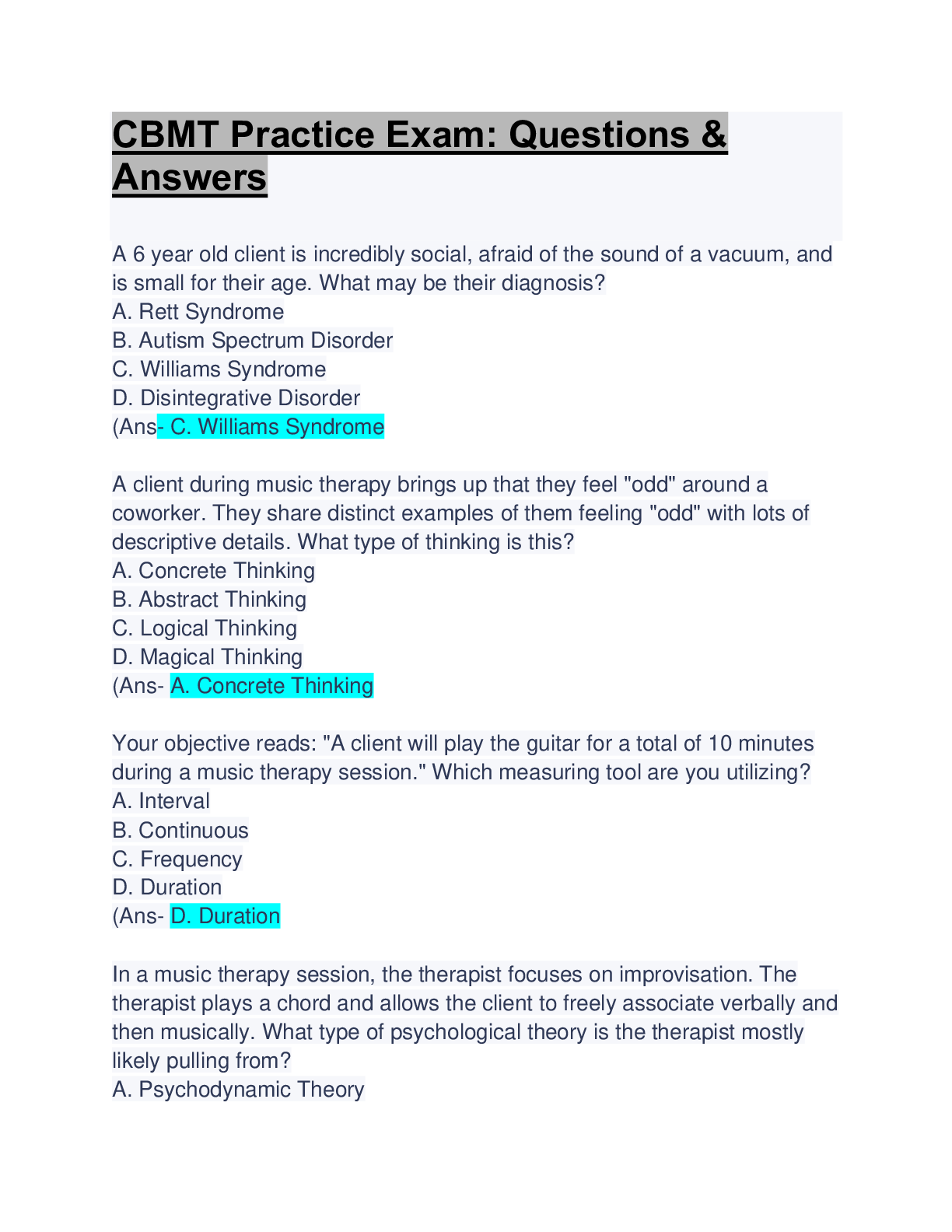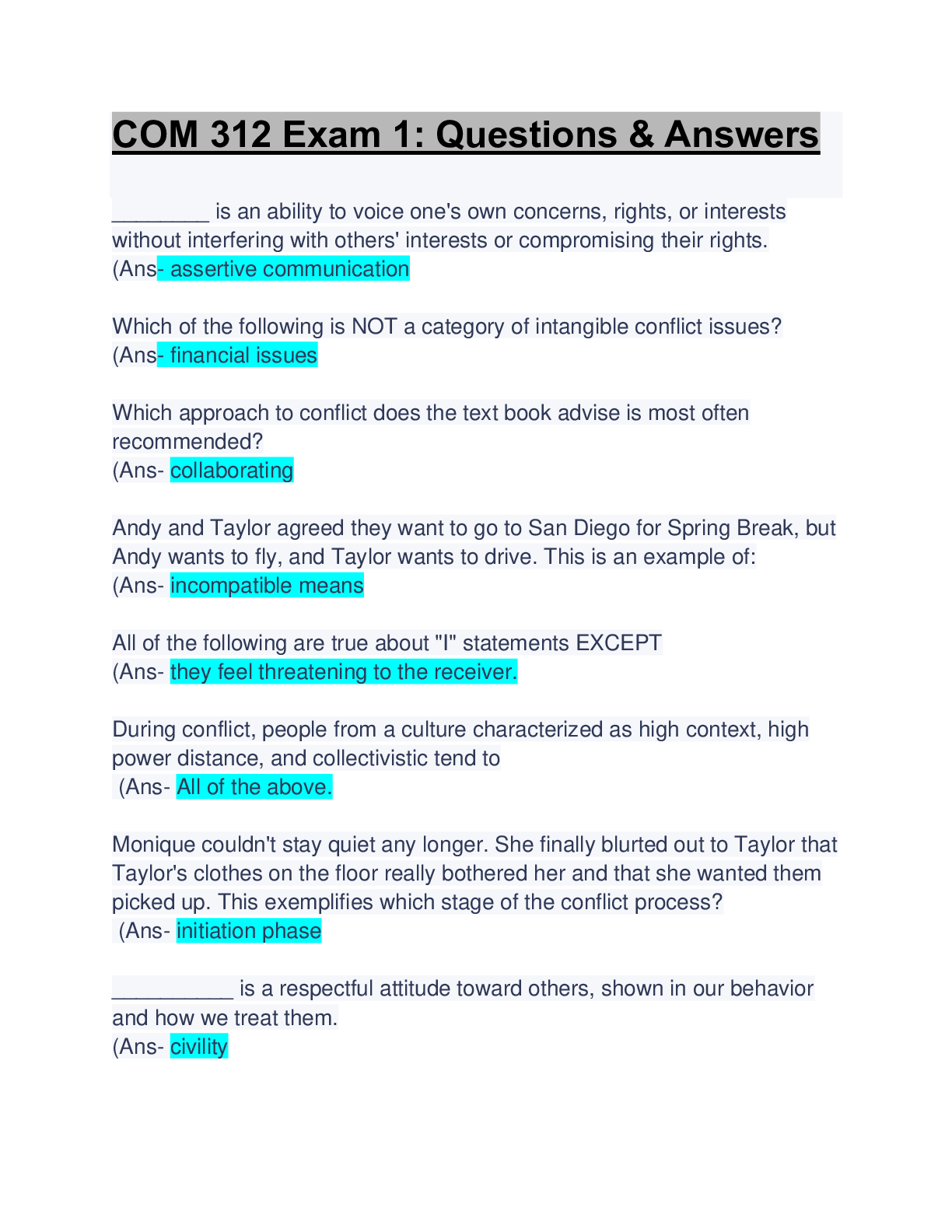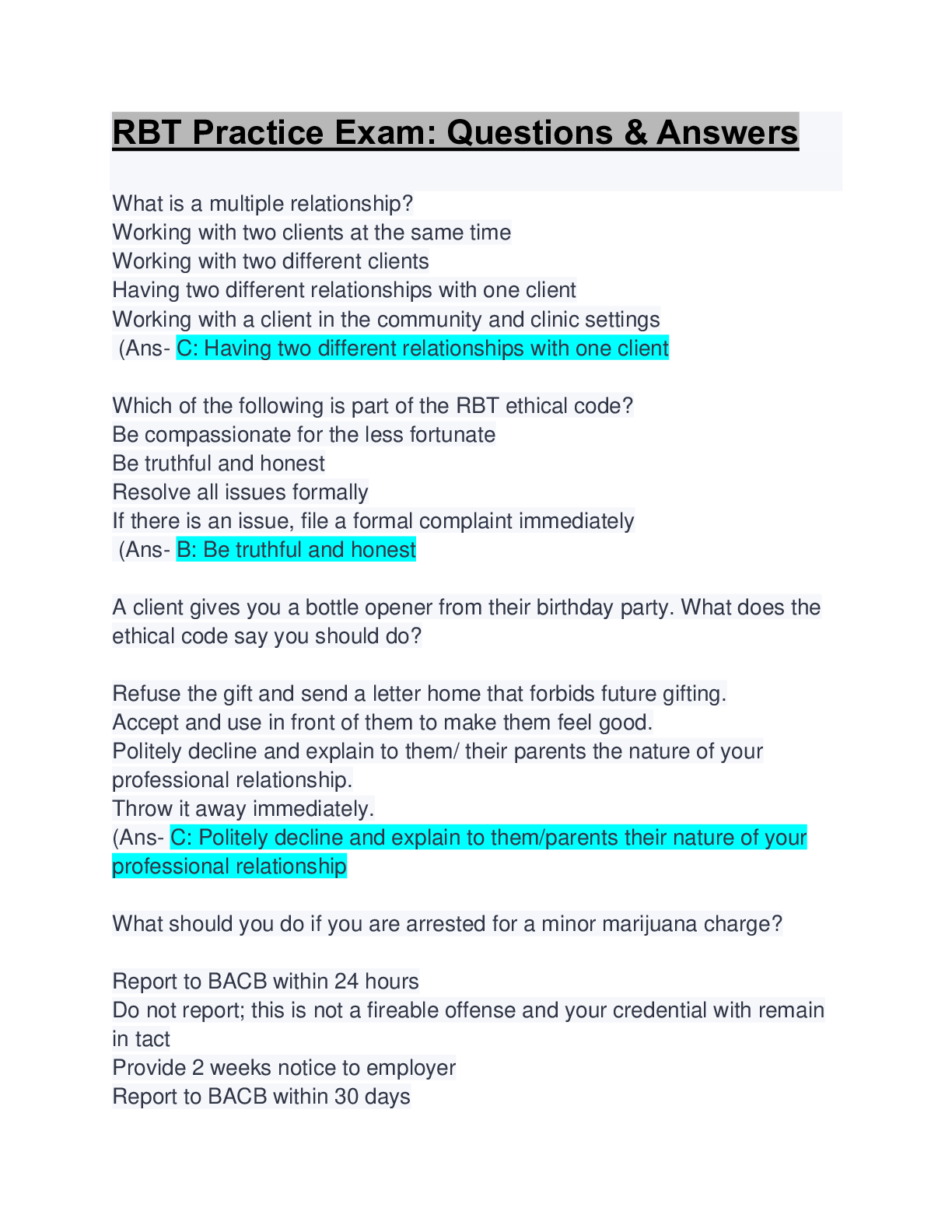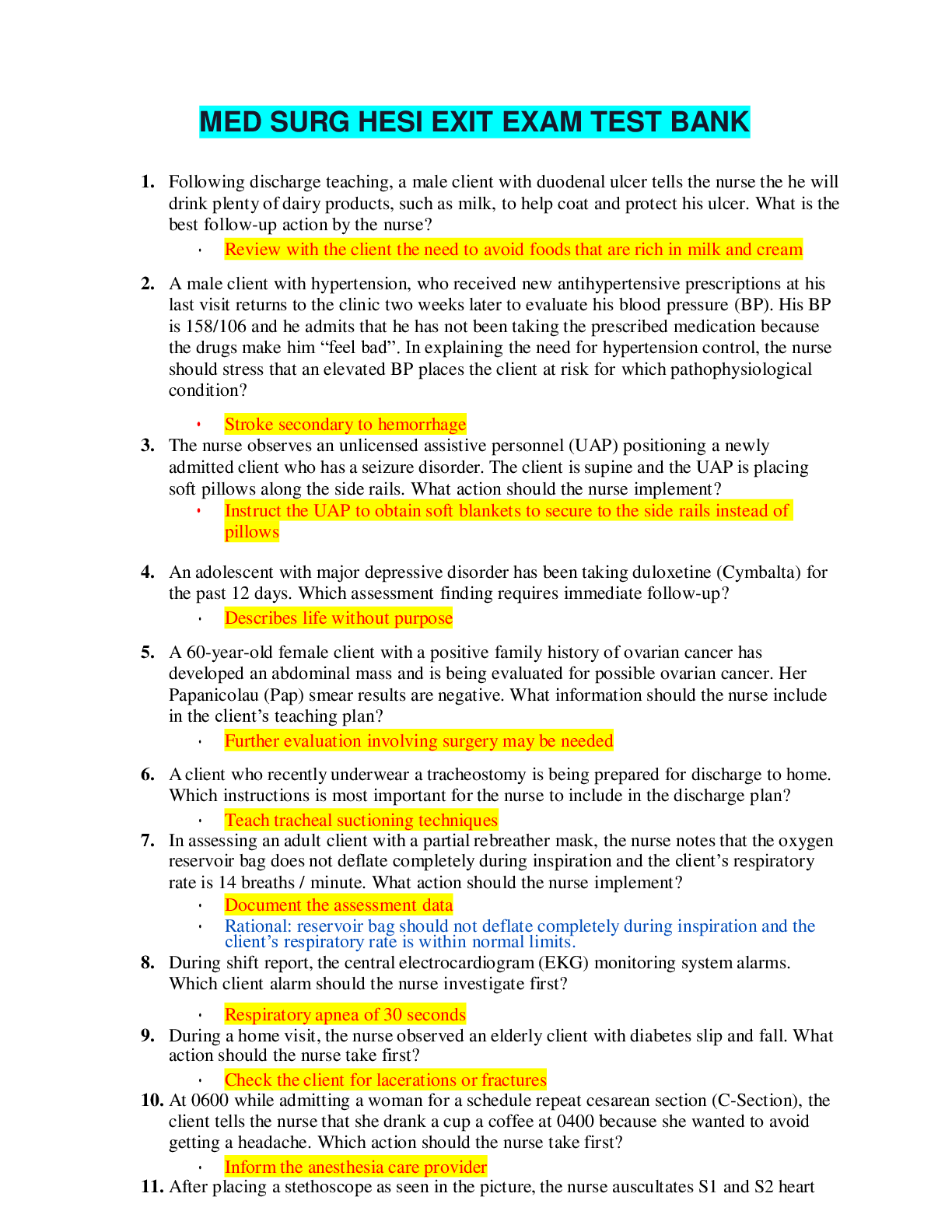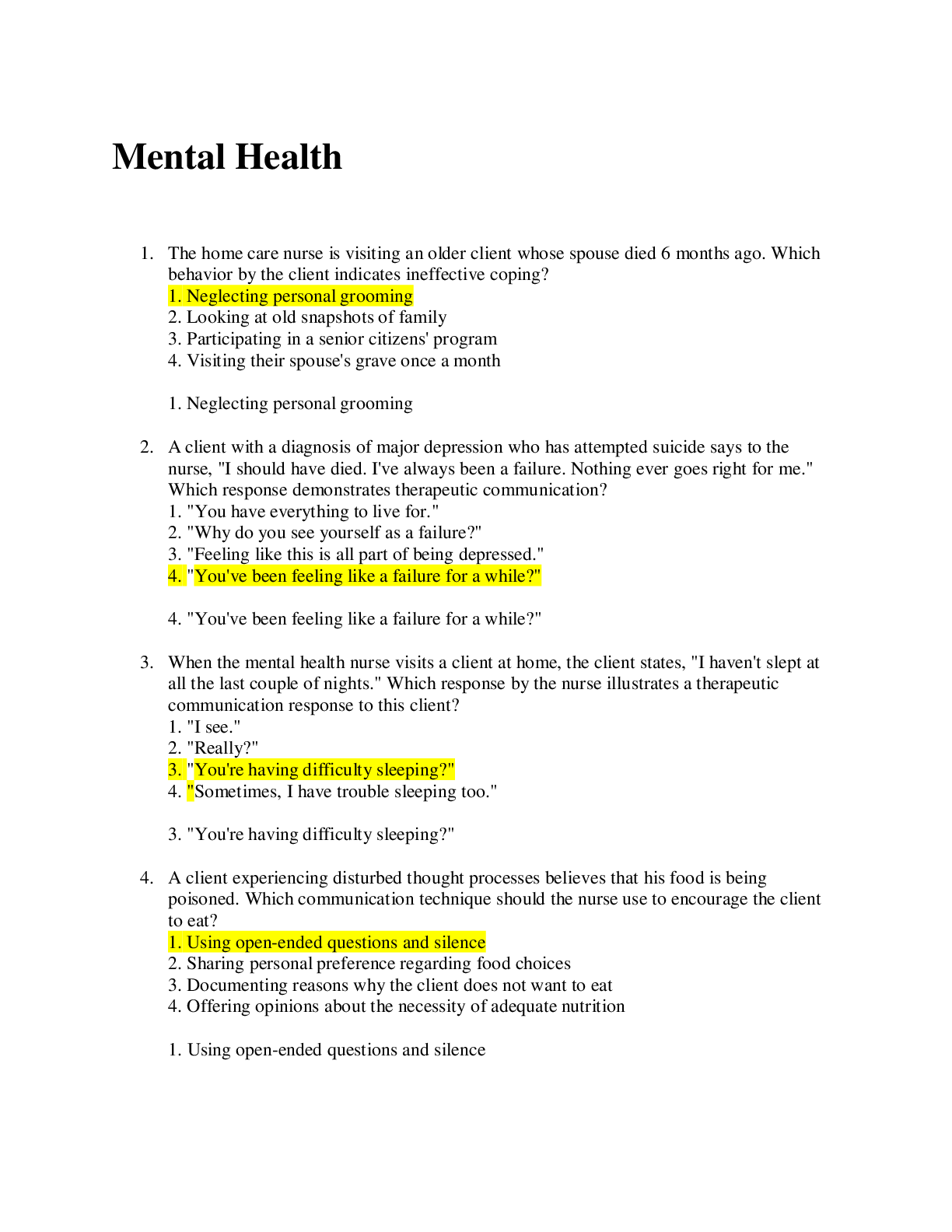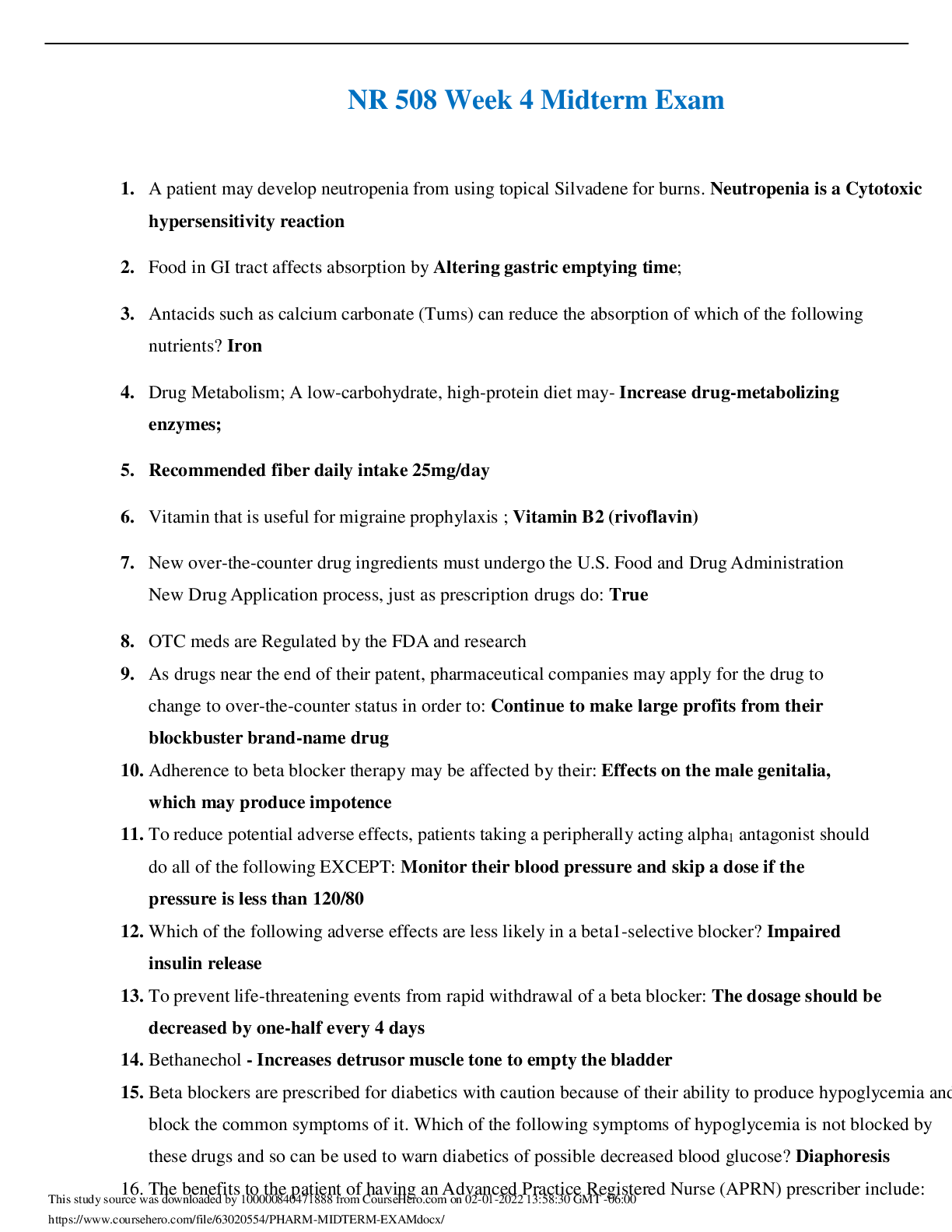Health Care > EXAM > EMT-B Final Exam Prep Test Bank - All JB Learning Quizzes: Questions & Answers: 100% Verified; Updat (All)
EMT-B Final Exam Prep Test Bank - All JB Learning Quizzes: Questions & Answers: 100% Verified; Updated A+ Score Guide Solution( Everything you need)
Document Content and Description Below
Which of the following descriptions MOST accurately portrays emergency medical services (EMS)? Select one: A. A team of health care professionals who are responsible for providing emergency care and... transportation to the sick and injured B. A system composed exclusively of emergency medical responders (EMRs) and emergency medical technicians (EMTs) who are responsible for providing care to sick and injured patients C. A team of paramedics and emergency physicians who are responsible for providing emergency care to critically injured patients D. A vast network of advanced life support (ALS) providers who provide definitive emergency care in the prehospital setting (Ans- A Which of the following courses requires about 150 hours of training? Select one: A. AEMT B. Paramedic C. EMR D. EMT (Ans- D Online medical control requires __________. Select one: A. phone or radio contact with the medical director B. written protocols approved by medical control C. a physician's presence on the scene of the call D. the presence of an advanced-level provider (Ans- A Which of the following statements regarding the NREMT is correct? Select one: A. EMS training standards are regulated by the NREMT. B. The NREMT is the exclusive certifying body for EMTs. C. The NREMT is a governmental agency that certifies EMTs. D. The NREMT provides a national standard for EMS testing. (Ans- D You are encouraging a patient to go to the hospital by ambulance. You know that a transport will keep you on duty several hours after your regular quitting time. This is an example of __________. Select one: A. scope of practice B. patient advocacy C. abuse of authority D. undue hardship (Ans- B Prehospital patient care decisions should be based on __________. Select one: A. the experiences of EMTs B. an EMS agency's fiscal resources C. EMS research D. the opinions of physicians (Ans- C The ability to handle multiple tasks based on their priority is called __________. Select one: A. integrity B. patient advocacy C. time management D. patient empathy (Ans- C Which of the following is a specific example of the Mobile Integrated Healthcare (MIH) model? Select one: A. The paramedic administers a patient's flu vaccination B. Paramedics pick up a patient from an acute care clinic C. EMTs assess a patient whose lung disease is "acting up" D. EMTs respond to a woman who complains of high fever (Ans- A National guidelines for EMS care are intended to __________. Select one: A. unify EMS providers under a single medical director B. provide more consistent delivery of EMS care across the United States C. reduce expenses at the local and state levels D. facilitate a national EMS labor group (Ans- B The EMT is legally obligated to protect a patient's privacy according to _____________. Select one: A. DCAP B. HIPAA C. APGAR D. CQI (Ans- B American Heart Association protocols are based on __________. Select one: A. trends in the EMS community B. opinions from a core group of cardiologists C. evidence-based research D. theories ready for field trial (Ans- C You are caring for a driver who struck a light pole. She admits to drinking alcohol but orders you not to tell anyone. You should report the information to __________. Select one: a. law enforcement personnel b. your medical director c. the receiving nurse or doctor d. the state motor vehicle department (Ans- C What should an EMT do to limit errors in the field? Select one: A. Carry an EMT text for reference at all times. B. Deviate from established standards when necessary. C. Follow the agency's written protocols. D. Contact medical direction before initiating any treatments. (Ans- C Which of the following statements regarding the Americans With Disabilities Act (ADA) of 1990 is correct? Select one: A. The ADA applies only to individuals with a diagnosed and well-documented physical disability. B. The ADA prohibits employers from failing to provide full and equal employment to those who are disabled. C. The minimum number of hours required to successfully complete an EMT course is less for candidates who are disabled. D. According to the ADA, EMT candidates with a documented disability are exempt from taking the NREMT exam. (Ans- B As an EMT, you may be authorized to administer aspirin to a patient with chest pain based on: Select one: A. medical director approval. B. an order from a paramedic. C. the transport time to the hospital. D. the patient's condition. (Ans- A The ability to take appropriate action with little direction is known as __________. Select one: A. time management B. diplomacy C. self-confidence D. self-motivation (Ans- D The ability to understand others and have them understand you is known as __________. Select one: A. teamwork and diplomacy B. scene leadership C. communication D. self-confidence (Ans- C Which of the following interventions is used by all levels of EMS providers? Select one: A. Automatic transport ventilators B. Automated external defibrillator C. Needle decompression D. Multilumen airways (Ans- B What is an EMT's primary service area? Select one: A. The only area the EMT is certified to provide patient care B. The main area in which the EMS agency operates C. The area serviced by the EMT's medical director D. The location where the EMT provides essential care during a 9-1-1 call (Ans- B The determination that prompt surgical care in the hospital is more important than performing time-consuming procedures in the field on a major trauma patient is based MOSTLY on: Select one: A. local protocols. B. the lead EMT's decision. C. regional trauma guidelines. D. EMS research. (Ans- D You are transporting an elderly woman who has possibly experienced a stroke. She is obviously scared but is unable to talk and cannot move the entire right side of her body. In addition to providing the medical care that she needs, you should: Select one: A. maintain eye contact at all times and tell her that there is no need for her to be scared. B. reassure her that after proper treatment in the hospital, she will regain her speech in time. C. acknowledge that she is scared and tell her that you will take good care of her. D. tell her that you understand why she is scared and that everything will likely be okay. (Ans- C Which of the following is an effective stress management strategy? Select one: A. Modestly increasing caffeine consumption B. Developing a social network outside of EMS C. Requesting overtime to occupy your mind D. Frequently reflecting on troublesome calls (Ans- B When decontaminating the back of your ambulance after a call, you should: Select one: A. spray the contaminated areas and then immediately wipe them dry with a towel. B. allow surfaces to air dry unless otherwise indicated in the product directions. C. clean all surfaces and patient contact areas with a mixture of alcohol and water. D. use a bleach and water solution at a 1:2 dilution ratio to thoroughly wipe all surfaces. (Ans- B While providing care to a patient, blood got onto the ambulance stretcher. Because the stretcher was not properly cleaned afterward, a virus was transmitted to another emergency medical technician (EMT) several days later. Which route of transmission does this scenario describe? Select one: A. Indirect contact B. Airborne transmission C. Direct contact D. Vector-borne transmission (Ans- A Which of the following statements regarding the different stages of the grieving process is correct? Select one: A. Bargaining is the most unpleasant stage of the grieving process. B. The stages of the grieving process may occur simultaneously. C. The grieving process typically begins with severe depression. D. It is rare that people will jump back and forth between stages. (Ans- B Vaccination against the hepatitis A virus is unnecessary if you: Select one: A. have been infected with hepatitis in the past. B. are older than 35 years of age. C. have a weak immune system. D. received a hepatitis B vaccination. (Ans- A Quid pro quo, a type of sexual harassment, occurs when the harasser: Select one: A. touches another person without his or her consent. B. stares at certain parts of another person's anatomy. C. requests sexual favors in exchange for something else. D. makes rude remarks about a person's body parts. (Ans- C Which of the following would provide the EMT with the BEST cover in a situation involving active gunfire? Select one: A. A concrete barricade B. Stacked empty barrels C. A large cluster of shrubs D. Behind a car door (Ans- A Which of the following statements regarding HIV is correct? Select one: A. HIV is transmitted exclusively via blood. B. There is no vaccine against HIV infection. C. HIV is easily transmittable in the EMS field. D. HIV is far more contagious than hepatitis B. (Ans- B The EMT's first priority is __________. Select one: A. treatment and transport B. rapid response C. personal safety D. empathy for all patients (Ans- C Upon arriving at the scene of a motor vehicle crash, you note that two small cars collided head-on; the occupants are still in their vehicles. The fire department is in the process of stabilizing the vehicles and law enforcement personnel are directing traffic. After parking the ambulance at a safe distance, you and your partner should: Select one: A. quickly begin the triage process. B. put on high-visibility safety vests. C. assist with vehicle stabilization. D. report to the incident commander. (Ans- B Vector-borne transmission of an infectious organism occurs via: Select one: A. inanimate objects. B. direct contact. C. animals or insects. D. smoke or dust. (Ans- C Gloves, a mask, eye protection, and a face shield should be used: Select one: A. when performing endotracheal intubation. B. while handling needles or other sharps. C. whenever you touch nonintact skin. D. during routine cleaning of the ambulance. (Ans- A Common factors that influence how a patient reacts to the stress of an illness or injury include all of the following, EXCEPT: Select one: A. assessment by the EMT. B. fear of medical personnel. C. history of chronic disease. D. mental disorders. (Ans- A The simplest, yet most effective method of preventing the spread of an infectious disease is to: Select one: A. wash your hands in between patient contacts. B. undergo annual testing for tuberculosis and hepatitis. C. ensure that your immunizations are up-to-date. D. undergo an annual physical examination. (Ans- A Which of the following scenarios MOST accurately depicts a posttraumatic stress disorder (PTSD) reaction? Select one: A. A newly certified EMT becomes extremely nauseated and diaphoretic at the scene of an incident involving grotesque injuries. B. An EMT with many years of field experience becomes irritable with her coworkers and experiences headaches and insomnia. C. An EMT becomes distracted at the scene of a motor vehicle crash involving the same type of car in which a child was previously killed. D. An EMT is emotionally exhausted and depressed after a school bus crash involving critical injuries and the death of several children. (Ans- C At the scene of an automobile crash, a utility pole has been broken and power lines are lying across the car. The patients inside the car are conscious. You should: Select one: A. advise the patients to carefully get out of the car. B. mark off a danger zone around the downed lines. C. proceed with normal extrication procedures. D. remove the lines with a nonconductive object. (Ans- B After assessing a patient's blood glucose level, you accidentally stick yourself with the contaminated lancet. You should: Select one: A. get immunized against hepatitis as soon as possible. B. immerse your wound in an alcohol-based solution. C. report the incident to your supervisor after the call. D. discontinue patient care and seek medical attention. (Ans- C The MOST serious consequence of drug or alcohol abuse among EMS personnel is: Select one: A. substandard or inappropriate patient care. B. punitive action and the loss of a job. C. low morale and frequently missed shifts. D. tension among coworkers and supervisors. (Ans- A General adaptation syndrome is characterized by which of the following phases? Select one: A. Immediate reaction, psychological exhaustion, and recovery B. Alarm response, reaction and resistance, and recovery C. Reaction and resistance, euphoria, and physical exhaustion D. Delayed reaction, alarm response, and physical recovery (Ans- B When performing his or her duties, the EMT is generally expected to: Select one: A. function above his or her scope of practice. B. contact medical control on every EMS call. C. exercise reasonable care and act prudently. D. consistently exceed the standard of care. (Ans- C You respond to the home of a 59-year-old man who is unconscious; has slow, shallow breathing; and has a weak pulse. The family states that the patient has terminal brain cancer and does not wish to be resuscitated. They further state that there is a DNR order for this patient, but they are unable to locate it. You should: Select one: A. decide on further action once the DNR order is produced. B. begin treatment and contact medical control as needed. C. honor the patient's wishes and withhold all treatment. D. transport the patient without providing any treatment. (Ans- B Which type of consent is involved when a 39-year-old mentally competent female with a severe headache asks you to take her to the hospital? Select one: A. Informed B. Formal C. Expressed D. Implied (Ans- C Which of the following statements about the patient care report is correct? Select one: a. It is difficult to prove actions were performed if they are not included on the report. b. EMTs are not liable for any actions that are accurately documented. c. Patient care cannot be discredited based on poor documentation. d. Incomplete reports are common and accepted in EMS. (Ans- A You and your partner arrive at the scene of a major motor vehicle crash. The driver, a young male, is severely entrapped in his car. He has an open head injury and massive facial trauma. He is unresponsive, is not breathing, and does not have a palpable carotid pulse. You should: Select one: A. stop any active bleeding and advise dispatch to send a paramedic crew. B. have your partner check for a pulse to confirm that the patient is deceased. C. request the fire department to extricate the patient so you can begin CPR. D. ventilate the patient for 5 minutes and then stop if there is no response. (Ans- B As an EMT, the standards of emergency care are often partially based on: Select one: A. the wishes of the general public. B. locally accepted protocols. C. the priorities of the medical director. D. a consensus among paramedic supervisors. (Ans- B Which aspect of the Health Insurance Portability and Accountability Act (HIPAA) MOST affects EMS personnel? Select one: A. Preventing insurance fraud B. Protecting patient privacy C. Controlling insurance costs D. Ensuring access to insurance (Ans- B Where would you MOST likely find information regarding a patient's wishes to be an organ donor? Select one: A. Driver's license B. Insurance card C. Voter registration card D. Social Security card (Ans- A Which of the following components are needed to prove negligence? Select one: A. Duty to act, breach of duty, injury/damages, and causation B. Breach of duty, injury/damages, abandonment, and causation C. Duty to act, abandonment, breach of duty, and causation D. Abandonment, breach of duty, damages, and causation (Ans- A To help protect patients, EMS agencies are required to have __________. Select one: A. public forums with their medical director B. a privacy officer to answer questions C. online access to patient records D. an anonymous reporting system (Ans- B Putrefaction is defined as: Select one: A. separation of the torso from the rest of the body. B. decomposition of the body's tissues. C. profound cyanosis to the trunk and face. D. blood settling to the lowest point of the body. (Ans- B When is forcible restraint permitted? Select one: A. Only if consent to restrain is given by a family member B. When the patient poses a significant threat to self or others C. Only if law enforcement personnel have witnessed threatening behavior D. Anytime that the EMT feels threatened (Ans- B You arrive at the scene of a motor vehicle-versus-pedestrian accident. The patient, a 13-year-old male, is unconscious and has multiple injuries. As you are treating the child, a law enforcement officer advises you that the child's parents will be at the scene in approximately 15 minutes. What should you do? Select one: A. Begin transport at once and have the parents meet you en route to the hospital. B. Transport the child immediately and have the parents meet you at the hospital. C. Withhold treatment until the parents arrive and give you consent for treatment. D. Treat the child at the scene and wait for the parents to arrive and give consent. (Ans- B During your monthly internal quality improvement (QI) meeting, you review several patient care reports (PCRs) with the staff of your EMS system. You identify the patient's name, age, and sex, and then discuss the treatment that was provided by the EMTs in the field. By taking this approach to the QI process, you: Select one: A. adequately safeguarded the patient's PHI because the cases were discussed internally. B. are in violation of HIPAA because you did not remove the PHI from the PCR beforehand. C. violated the patient's privacy because you should have discussed the information only with the EMTs involved. D. acted appropriately but must have each EMT sign a waiver stating that he or she will not discuss the cases with others. (Ans- B You are called to attend to an elderly patient with an extensive medical history who is now in cardiac arrest. The patient's family tells you that the patient has a DNR order. There is no paperwork available but the patient does have a MedicAlert bracelet indicating Do Not Resuscitate. You should: Select one: A. confirm the patient identity and then confirm the DNR by calling the MedicAlert Foundation number on the bracelet. B. confirm the patient's identity and honor the DNR order. C. initiate resuscitation in the absence of paperwork. D. transport with minimal care. (Ans- A In which of the following circumstances can the EMT legally release confidential patient information? Select one: A. The patient is competent and signs a release form B. A police officer requests a copy to place on file C. A media representative inquires about the patient D. The family requests a copy for insurance purposes (Ans- A The EMT's scope of practice within his or her local response area is defined by the: Select one: A. EMS supervisor. B. medical director. C. local health district. D. state EMS office. (Ans- B Maintaining the chain of evidence at the scene of a crime should include: Select one: A. placing the patient in a private area until the police arrive. B. not cutting through holes in clothing that were caused by weapons. C. making brief notes at the scene and then completing them later. D. quickly moving any weapons out of the patient's sight. (Ans- B In which of the following situations does a legal duty to act clearly exist? Select one: A. A call is received 15 minutes prior to shift change. B. A bystander encounters a victim who is not breathing. C. The EMT hears of a cardiac arrest after his or her shift ends. D. The EMT witnesses a vehicle crash while off duty. (Ans- A Which of the following general statements regarding consent is correct? Select one: A. All patients older than 18 years can legally refuse treatment or transport. B. A patient can consent to transport but can legally refuse to be treated. C. Patients who are intoxicated are generally allowed to refuse treatment. D. Expressed consent is valid only if given in writing by a family member. (Ans- B Which of the following will help improve radio communications? Select one: A. Use codes to speed communication. B. Hold the radio at least 6 inches from your mouth. C. Answer questions with "yes" or "no." D. Wait 1 second after pressing the transmit button before speaking. (Ans- D Which of the following types of questions allow for the most detailed response? Select one: A. Open-ended questions B. Yes or no questions C. Multiple questions asked at once D. Closed-ended questions (Ans- A You are dispatched to the residence of an Asian family for a child with a high fever. When you assess the child, you note that he has numerous red marks on his back. The child's parents explain that these marks represent coining—a traditional Asian healing practice in which hot coins are rubbed on the back. You should: Select one: A. advise the child's parents that this is a harmful practice and is considered a form of child abuse in the United States. B. acknowledge and respect this practice as a cultural belief, but advise the child's parents that it has no healing power. C. advise the emergency department physician that you feel as though the child was intentionally abused by his parents. D. document this finding on your patient care report and advise the emergency department staff of what the child's parents told you. (Ans- D At the scene of a motor vehicle crash, you determine that there are two critically injured patients and that another ambulance is needed. You attempt to contact the dispatcher with your portable radio but are unsuccessful. You should: Select one: A. make another attempt to contact dispatch from an area of higher terrain. B. ask a police officer to call dispatch with his portable radio. C. place both patients in the ambulance and transport them at once. D. use the mobile radio in the ambulance to contact dispatch. (Ans- D Which of the following is NOT a function of the Federal Communications Commission (FCC)? Select one: A. Licensing base stations and assigning appropriate radio call signs B. Monitoring all radio traffic and conducting field spot checks C. Maintaining communications equipment on the ambulance D. Allocating specific radio frequencies for use by EMS providers (Ans- C [Show More]
Last updated: 1 year ago
Preview 1 out of 207 pages

Reviews( 0 )
Document information
Connected school, study & course
About the document
Uploaded On
Nov 24, 2022
Number of pages
207
Written in
Additional information
This document has been written for:
Uploaded
Nov 24, 2022
Downloads
0
Views
60
